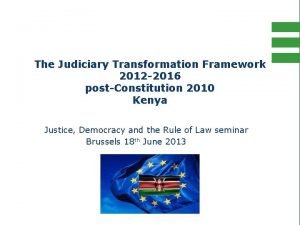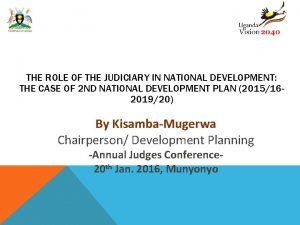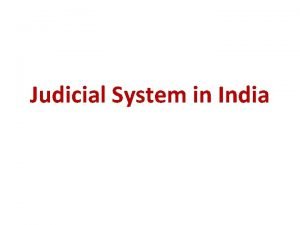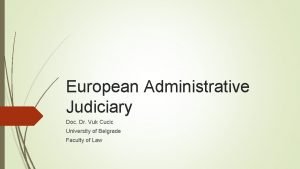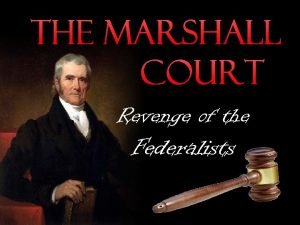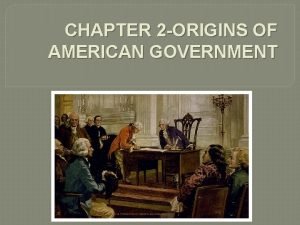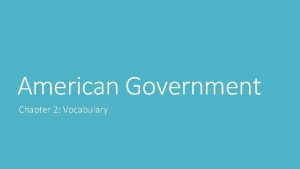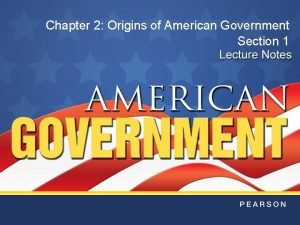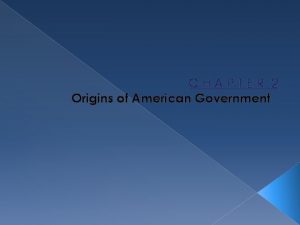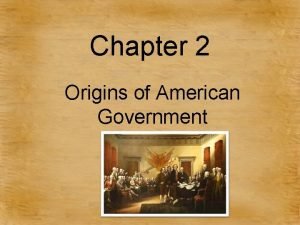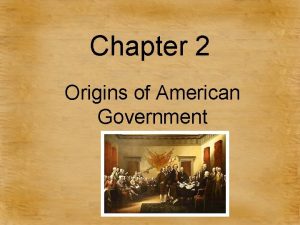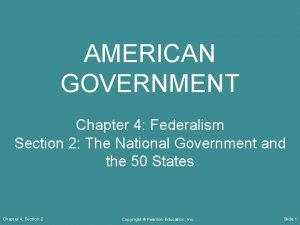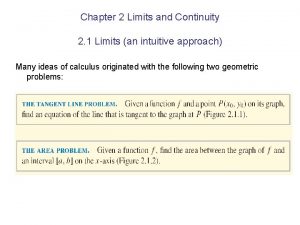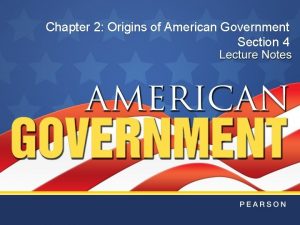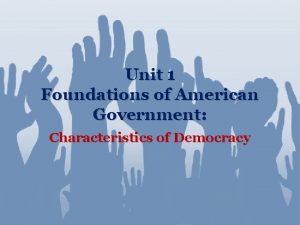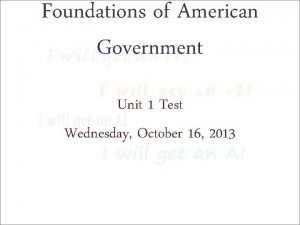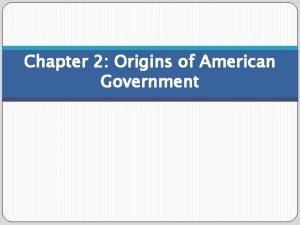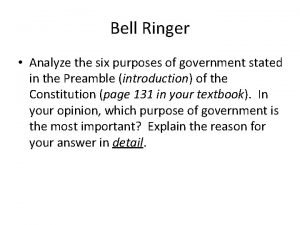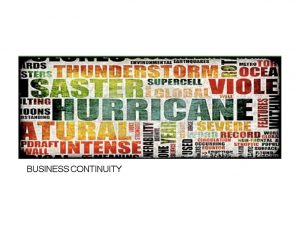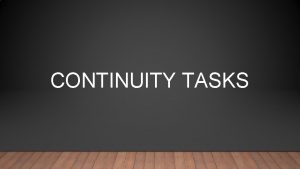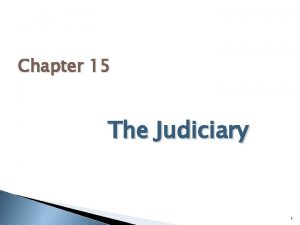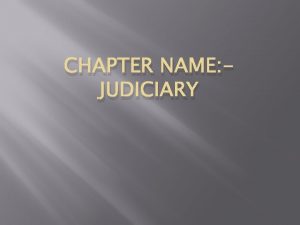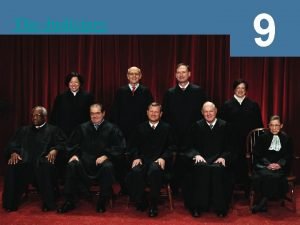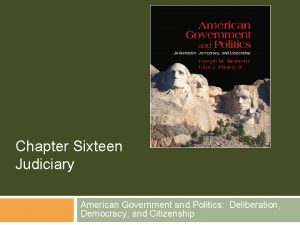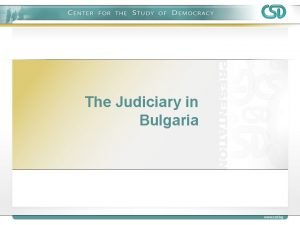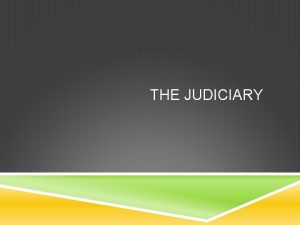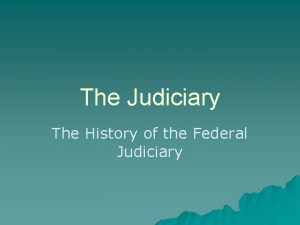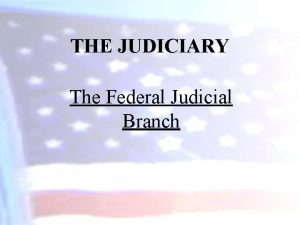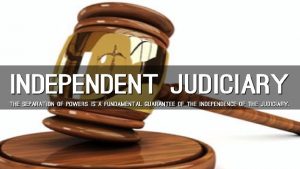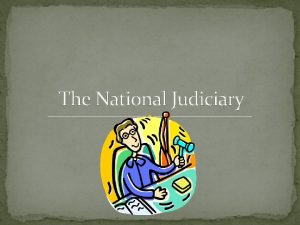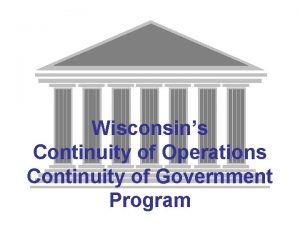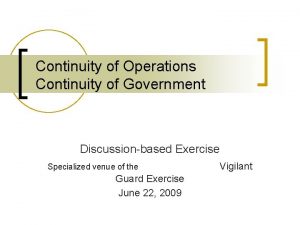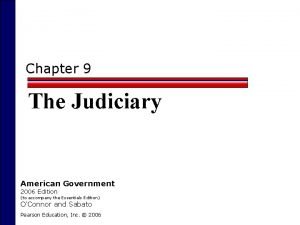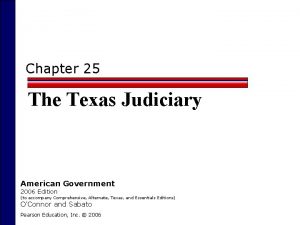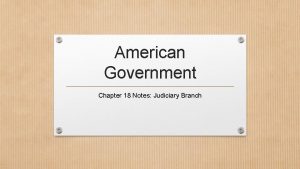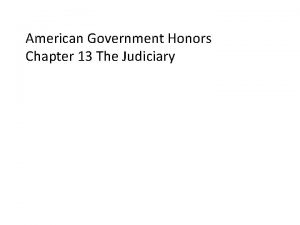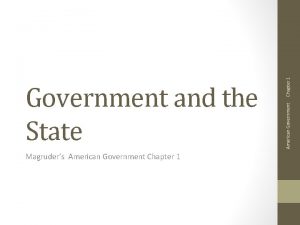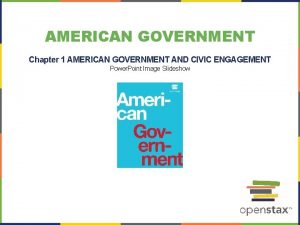Chapter 10 The Judiciary American Government Continuity and













































- Slides: 45

Chapter 10 The Judiciary American Government: Continuity and Change 9 th Edition to accompany Comprehensive, Alternate, Texas, and Essentials Editions O’Connor and Sabato Pearson Education, Inc. © 2008

The Constitution and the Creation of the Federal Judiciary o Framers devoted little time to the creation of the judiciary. n Believed it posed little of the threat of tyranny they feared from the other two branches n Hamilton: “least dangerous branch” n Anti-federalists did see the judiciary as a threat. o Life tenure o Supreme law of the land o Compromise left it to Congress to design the federal judiciary.


Article III o Did not settle the question of judicial review n Not explicitly stated in the Constitution n Allows the judiciary to review the constitutionality of acts of the other branches of government and the states o Judicial review settled with Marbury v. Madison (1803) for national government’s acts and Martin v. Hunter’s Lessee (1816) regarding state law

Article III o Section I gave Congress the authority to establish other courts as it saw fit. o Section II specifies the judicial power of the Supreme Court and discusses the Court’s original and appellate jurisdiction. n Also specifies that all federal crimes, except those involving impeachment, shall be tried by jury in the state in which the crime was committed o Section III defines treason and mandates that at least two witnesses appear in such cases.

Article III o Framers gave federal judges tenure for life “with good behavior” n Did not want judges to be subject to the whims of politics, n o the public, or politicians Hamilton argued in Federalist 78 that the “independence of judges” was needed “to guard the Constitution and the rights of individuals. ” Some checks on judiciary included: n Congress has the authority to alter the Court’s jurisdiction. n Congress can propose constitutional amendments that, if n n ratified, can effectively reverse judicial decisions. Congress can impeach and remove federal judges. President (with advise and consent of Senate) appoints federal judges

The Judiciary Act of 1789 and the Creation of the Federal Judicial System o Established the basic three-tiered structure of the federal court system n District courts: at least one in each state, each staffed by a federal judge n Circuit Court: avenue for appeal o Each circuit court initially composed of one district court judge and two itinerant Supreme Court Justices who met as a circuit court twice a year n Supreme Court size set in the Act – chief justice and five associates o Number of justices set to 9 in 1869

The Judiciary Act of 1789 and the Creation of the Federal Judicial System o First session of the Supreme Court initially had to be adjourned when a quorum of the justices failed to show up o John Jay, Chief Justice o Later, the court decided only one major case: n Chisholm v. Georgia (1793) o Relatively lowly status n One associate judge left to become chief justice of a state supreme court. n Limitations in space, support, no system for reporting its decisions

The Early Court o First decade, Court not co-equal but it did assert itself n Declined to give President Washington advice on the legality of some of his actions o Attempted to establish the Court as an independent, nonpolitical branch n Tried to advance principles of nationalism and to maintain the national government’s supremacy over the states n Began to pave the way for announcement of the doctrine of judicial review

The Marshall Court: Marbury v. Madison (1803) and Judicial Review o Marbury v. Madison n Supreme Court first asserted the power of judicial review in finding that the congressional statute extending the Court’s original jurisdiction was unconstitutional n Marshall claimed this sweeping authority for the Court by asserting that the right of judicial review was a power that could be implied from the Constitution’s supremacy clause. o The immediate effect was to deny power to the Court. o The long-term effect was to establish the power of judicial review.

The American Legal System o o Trial courts n Courts of original jurisdiction where a case begins Appellate courts n Courts that generally review only findings of law made by lower courts o Jurisdiction n Authority vested in a particular court to hear and decide the n issues in any particular case Original jurisdiction: The jurisdiction of courts that hears a case first, usually in a trial o Courts determine the facts of a case under their original jurisdiction. n Appellate jurisdiction: The power vested in an appellate court to review and/or revise the decision of a lower court


The American Legal System o Criminal law n Codes of behavior related to the protection of property and individual safety o Civil law n Codes of behavior related to business and contractual relationships between groups and individuals

The Federal Court System o Constitutional courts n Federal courts specifically created by the U. S. Constitution or Congress pursuant to its authority in Article III o Legislative courts n Courts established by Congress for specialized purposes, such as the Court of Military Appeals

The Federal Court System o District Courts n 94 federal district courts staffed by 646 active judges, assisted by more than 300 retired judges n No district courts cross state lines n Every state has at least one federal district court n The most populous states have four. (CA, TX, and NY)


Original Jurisdiction of Federal District Courts o Involve the federal government as a party o Present a federal question based on a claim under the U. S. Constitution, a treaty with another nation, or a federal statute n Called federal question jurisdiction and can involve criminal or civil law o Involve civil suits in which citizens are from different states, and the amount of money at issue is more than $75, 000

District Courts o Each federal judicial district has a U. S. attorney. n This individual is nominated by the president and confirmed by the senate. n The attorney is that district’s chief law enforcement officer. n They have a considerable amount of discretion as to whether they pursue criminal or civil investigations or file charges against individuals or corporations. n Springboard to elective office o NY City Mayor Rudy Giuliani

The Courts of Appeals o o o The losing party in a case heard and decided in a federal district court can appeal the decision to the appropriate court of appeals. 11 numbered circuit courts Twelfth, D. C. Court of Appeals n o Thirteenth, U. S. Court of Appeals for the Federal Circuit n o o o Handles most appeals involving federal regulatory commissions and agencies Deals with patents and contract and financial claims against the federal government Have no original jurisdiction Try to correct errors of law and procedure that have occurred in the lower courts or administrative agencies Hear no new testimony n Briefs submitted to them containing legal written arguments in a case

The Courts of Appeals o Decisions of the court of appeals are binding on only the district courts within the geographic confines of the circuit o Decisions of the Supreme Court are binding throughout the nation and establish national precedents n Reliance on past decisions or precedents to formulate decisions in new cases is called “stare decisis. ” n Allows for continuity and predictability

The Supreme Court o Often the center of highly controversial issues o Reviews cases from the U. S. courts of appeals and state supreme courts (as well as other courts of last resort) o Acts as the final interpreter of the Constitution o Ensures uniformity in the interpretation of national laws and the Constitution o Resolves conflicts among the states o Maintains the supremacy of national law in the federal system o 8 justices and one chief justice o Relatively few support staff n Clerks plus 400 staff members


How Federal Court Judges Are Selected o Often a very political process o Judges nominated by president and confirmed by Senate o Can reflect the ideological stamp of the president o Senatorial Courtesy n A process by which presidents, when selecting district court judges, defer to the senator in whose state the vacancy occurs

Who Are Federal Judges? o Typically they have held other political offices. n State court judge or prosecutor n Most have been involved in politics. n White males tend to dominate.



Appointments to the U. S. Supreme Court o Nomination Criteria n Competence n Ideology or Policy Preference o Strict constructionist: an approach to constitutional interpretation that emphasizes the Framer’s original intentions n n Rewards Pursuit of Political Support Religion Race, Ethnicity, and Gender


The Supreme Court Confirmation Process o o Investigation Lobbying by Interest Groups Senate Committee Hearings Senate Vote n Few recent confirmations have been close; closest in recent history o Clarence Thomas 52 -48 (1991) o Samuel A. Alito 58 -42 (2005)



The Supreme Court Today o Surprising that so many Americans know next to nothing about the judicial system o Half surveyed in 2006 could not name a single member of the court n Lack of interest n Court’s privacy and sense of decorum n Does not televise its proceedings

The Supreme Court Today: Deciding to Hear a Case o Nearly 8, 000 cases were filed at the Supreme Court in its 2005 -2006 term. n 87 heard, 74 decisions issued n Early years relatively few cases decided o Main duty: riding the circuit n 1940 s fewer than 1000 cases filed annually n Increased over time n Modern period, many of the cases have involved Bill of Rights issues



Supreme Court Today o o Court has two types of jurisdiction: n n Original Appellate n A request for the court to order up the records from a lower court to review the case Rule of Four Writ of certiorari n o Court controls its caseload through the certiorari process. o All petitions for certiorari must meet two criteria: n n n The case must come either from a U. S. court of appeals, a special three-judge district court, or a state court of last resort. Case must involve a federal question. This means that the case must present questions of interpretation of federal constitutional law or involve a federal statute, action or treaty. Cert pool Discuss list Cert granted when at least four justices vote to hear a case Role of clerks

How Does a Case Survive the Process? o Characteristics of the cases the Court accepts: n The federal government is the party asking for review. o Solicitor General n The case involves conflict among circuit courts. n The case presents a civil rights or civil liberties question. n The case involves ideological and/or policy preferences of the justices. n The case has significant social or political interest, as evidenced by the presence of interest group amicus curiae briefs.


Hearing and Deciding a Case o Oral arguments o The conference and the vote o Writing opinions


Judicial Philosophy and Decision Making o Judicial restraint: n A philosophy of judicial decision making that argues courts should allow the decisions of other branches of government to stand, even when they offend a judge’s own sense of principles o Strict Constructionist o Judicial activism: n A philosophy of judicial decision making that argues judges should use their power broadly to further justice, especially in the areas of equality and personal liberty

Models of Judicial Decision Making o Behavior Characteristics n Social background o The Attitudinal Model o Strategic Model

Public Opinion o Justices are exposed to information regarding the public’s attitudes on issues. n Can act as a check on the power of the courts as well as an energizing factor n Webster example o Court subjected to lobbying, marches, etc.


Judicial Policy Making and Implementation o Policy making: n More than one hundred federal laws have been declared unconstitutional. n Ability to overrule itself o Judicial Implementation: n Refers to how and whether judicial decisions are translated into actual public policies affecting more than the immediate parties to a lawsuit
 Jusicial restraint
Jusicial restraint Uae national agenda
Uae national agenda Absolute continuity implies uniform continuity
Absolute continuity implies uniform continuity Judicial transformation framework
Judicial transformation framework Department of judiciary
Department of judiciary Judiciary system in india
Judiciary system in india Vuk cucic
Vuk cucic Whats the judiciary act
Whats the judiciary act Chapter 2 american government
Chapter 2 american government Chapter 2 origins of american government vocabulary
Chapter 2 origins of american government vocabulary Chapter 2 origins of american government answer key
Chapter 2 origins of american government answer key Chapter 2: origins of american government worksheet answers
Chapter 2: origins of american government worksheet answers Chapter 2 lesson 1 origins of american government
Chapter 2 lesson 1 origins of american government Chapter 2 origins of american government
Chapter 2 origins of american government Chapter 4 federalism answer key
Chapter 4 federalism answer key National government vs federal government
National government vs federal government Limits
Limits Origins of american government section 4
Origins of american government section 4 Ap gov unit 1 study guide
Ap gov unit 1 study guide Unit 1 foundations of american government
Unit 1 foundations of american government Origins of american government section 1
Origins of american government section 1 Foundations of american government unit test
Foundations of american government unit test Origins of american government section 1
Origins of american government section 1 Six purposes of government
Six purposes of government Hát kết hợp bộ gõ cơ thể
Hát kết hợp bộ gõ cơ thể Slidetodoc
Slidetodoc Bổ thể
Bổ thể Tỉ lệ cơ thể trẻ em
Tỉ lệ cơ thể trẻ em Gấu đi như thế nào
Gấu đi như thế nào Chụp phim tư thế worms-breton
Chụp phim tư thế worms-breton Alleluia hat len nguoi oi
Alleluia hat len nguoi oi Các môn thể thao bắt đầu bằng tiếng đua
Các môn thể thao bắt đầu bằng tiếng đua Thế nào là hệ số cao nhất
Thế nào là hệ số cao nhất Các châu lục và đại dương trên thế giới
Các châu lục và đại dương trên thế giới Công thức tính thế năng
Công thức tính thế năng Trời xanh đây là của chúng ta thể thơ
Trời xanh đây là của chúng ta thể thơ Mật thư tọa độ 5x5
Mật thư tọa độ 5x5 Làm thế nào để 102-1=99
Làm thế nào để 102-1=99 Phản ứng thế ankan
Phản ứng thế ankan Các châu lục và đại dương trên thế giới
Các châu lục và đại dương trên thế giới Thể thơ truyền thống
Thể thơ truyền thống Quá trình desamine hóa có thể tạo ra
Quá trình desamine hóa có thể tạo ra Một số thể thơ truyền thống
Một số thể thơ truyền thống Cái miệng nó xinh thế
Cái miệng nó xinh thế Vẽ hình chiếu vuông góc của vật thể sau
Vẽ hình chiếu vuông góc của vật thể sau Thế nào là sự mỏi cơ
Thế nào là sự mỏi cơ



